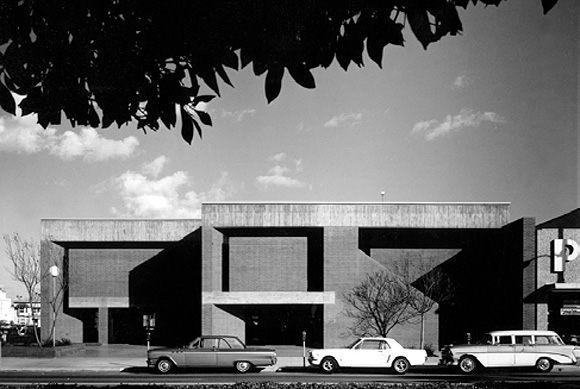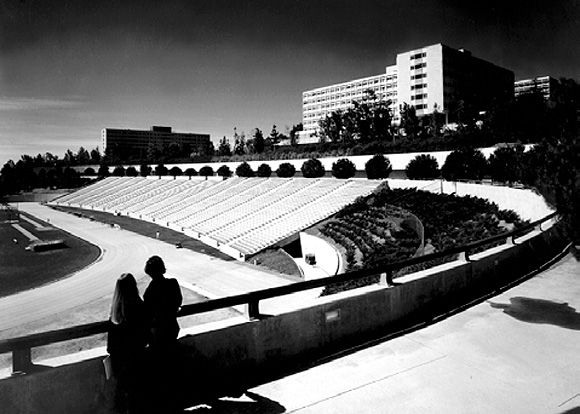
arcCA: You have won a lot of impressive awards. What does the Lifetime Achievement Award mean to you, as compared with other awards you have received?
Dworsky: I am very honored by this award. I think it sums up a lifetime of effort and is a wonderful recognition from my peers, since I’m now retired. It’s nice that people retain good thoughts about you. It’s a boost.
arcCA: When did you retire?
Dworsky: On July 1, 2003, I retired from active practice with the merged firms of Dworsky Associates and Cannon Design. The Cannon firm maintains an office for my use. I still provide a limited amount of consulting services as an individual for clients such as the Federal Reserve Bank and the City of Beverly Hills. I am also looking forward to assisting my son, Doug Dworsky, a talented architect, who is now pursuing the real estate development field.

arcCA: You have had essentially two careers, one as a college and professional football player and another as an architect. Were you able to bring any lessons from your career in football to your career as an architect?
Dworsky: Yes, there is a definite correlation. The lessons of hard work and sacrifice lead more often to success than not. There are a number of lessons that you learn in athletics, including working harmoniously with people and working as a team. Architects utilize such operative skills working with team members, persevering when times are tough, and pursuing mutual goals aggressively—these skills retained from competitive sports.

arcCA: Many successful architects have a project that serves as the turning point in the career. Is there one for you?
Dworsky: It was the Crisler Arena at the University of Michigan. That was the first major public building that I had the opportunity to design, and it opened up the opportunities for other college, institutional, and public facilities.
arcCA: Michigan is your alma mater; that must have been an exciting project for you.
Dworsky: Michigan’s basketball program was on the rise. Fritz Crisler, the Athletic Director at the University of Michigan and also my football coach, initiated the program to build a new arena. I had to compete with other architects for the project and, when selected, it was a dream opportunity.

arcCA: Now, I know you often say that the Theater Building at California State University, Dominguez Hills is one of your favorites. Why is that?
Dworsky: It is one of my favorites, because I look at it as a pure concrete sculpture on a unique site. Most of the sites that we have to work with are limited by numerous constraints, but this site had a park-like environment with unusual grades. I had the opportunity to work with Quincy Jones, the campus architect, who was sympathetic with my work. Because of Quincy, I was able to do something more aggressive architecturally. I was very proud to produce this building within a slim budget and a demanding schedule.
arcCA: You have been practicing as an architect for close to six decades on different projects and building types in various aesthetics. Are there any common threads that weave throughout your work?
Dworsky: I believe the common thread is the use of simple, straightforward, functional planning, which leads to concepts that achieve spatial excitement with structural integrity. I often used a limited palette of natural materials, such as concrete, brick, and wood. I preferred developing non-traditional forms using traditional materials.

arcCA: It sounds as if you view all your projects as sculpture.
Dworsky: As I mentioned, the building’s functional integrity is of prime importance. I pursued spatial excitement through the sculptural aspects of each concept and avoided traditional references, so as to maintain the abstract experience. I was fortunate to work for Raphael Soriano when I arrived in Los Angeles after graduation. I had focused on the work of Mies van der Rohe during my fifth year at the University of Michigan and was recommended by John Entenza of Arts and Architecture magazine to fill an opening in Soriano’s office. The experience with Soriano, whose work was influenced by van der Rohe, significantly shaped my understanding of architecture. He was uniquely skilled and aesthetically disciplined.
arcCA: You have mentored an impressive roster of architects; you must feel a sense of pride knowing that you have been an influence in so many careers.
Dworsky: I benefited significantly from working with these special individuals, and I was fortunate to have them as members of our firm. It was clearly a two-way street. The work that each individual produced and the numerous discussions significantly enhanced my own education and direction. Jon Jerde, for instance, had a significant impact on the early work of our office, as Mehrdad Yazdani has had on the recent work. I’ve been very fortunate to have been associated with some of the most talented individuals in our profession.

arcCA: It’s impressive that you found success quite early in your career.
Dworsky: The situation was quite different back in the early ‘50s, when I got started. The country was in a strong growth period following the Second World War. It was much easier for a young practitioner with little experience to get started. Our profession has become more complex. We now face more regulation, greater legal and technical challenges, and as a result one must be prudent and cautious when initiating one’s own practice. It is now, more than ever, important to obtain the right experience with a good professional firm providing the desired mentoring opportunities to prepare for one’s future. The profession can be very exciting and rewarding in many ways.
arcCA: What kind of advice would you give to a young architect starting out in the field?
Dworsky: First, I recommend that one should seek experience with an outstanding office or individual in the profession. This significantly extends one’s education, so important in this complex, difficult, but exciting pursuit. Don’t expect high rates of compensation initially; the most important factor is to obtain valuable experience that will make your future both professionally and monetarily satisfying.

Interviewer Christel Bivens Kanda is a Marketing Coordinator at Cannon Design in Los Angeles. Previously, she worked at Payette Associates in Boston. She received her Bachelor of Arts from Smith College in Northampton, Massachusetts.
Originally published 3rd quarter 2004 in arcCA 04.3, “Photo Finish.”





